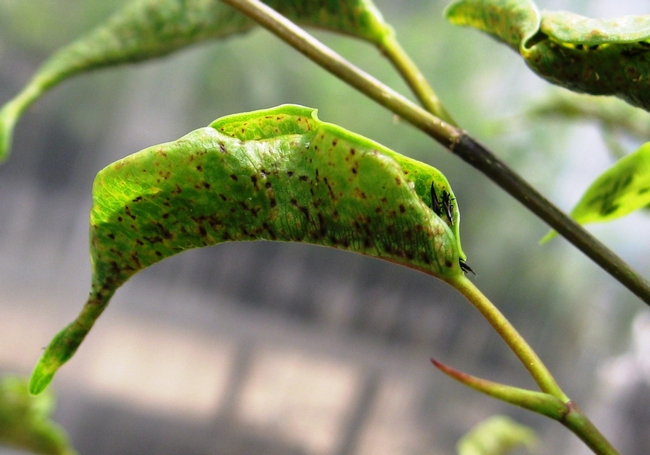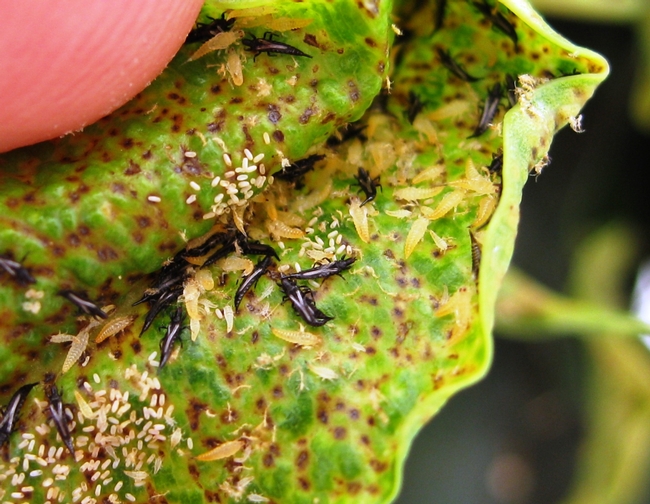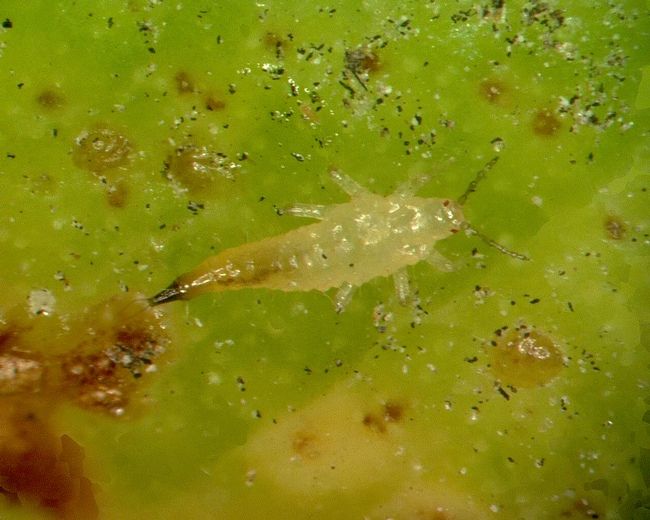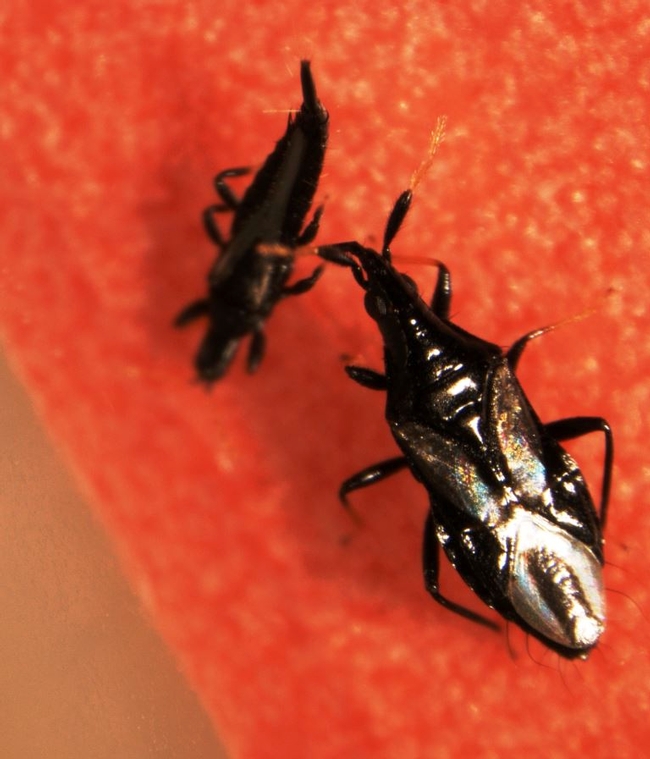Adult weeping fig thrips, larva, and eggs. (Photo by Gevork Arakelian, Senior Biologist, Los Angeles County)
Another exotic pest has recently found its way to California. Los Angeles County entomologist, Gevork Arakelian, identified the thrips in infested weeping fig samples sent by CE Advisor in Los Angeles, Donald Hodel in January, 2014, as weeping fig thrips. These infestations were discovered by Linda Ohara of El Camino College in Torrence, California. In the second week of April, 2014 Santa Barbara County entomologist, Brian Cabrera received Ficus microcarpa L. leaf samples infested with thrips from Hope Ranch, which CDFA later identified as weeping fig thrips and Cuban laurel thrips.
Weeping fig thrips, Gynaikothrips uzeli Zimmerman belongs to the largest family of Phlaeothripidae in the order Thysanoptera. It is a dark colored thrips with a stout body. It is very similar to Cuban laurel thrips, G. ficorum (Marchal) except for a minor morphological characteristic - the length of the pronotal posteroangular pair of setae. The length of the posteroangular setae is short for Cuban laurle thrips, while it is long for weeping fig thrips. Weeping fig thrips primarily infests weeping fig, F. benjamina L. (Moraceae) and Cuban laurel thrips primarily infests F. microcarpa, which is known as Indian laurel, Chinese banyan, or curtain fig.
Origin and distribution: Weeping fig thrips is native to southeastern Asia and has been found in other countries such as Belize and Trinidad and Tobago. In the United States, it was first reported in 2003 in Florida on weeping fig which is a popular ornamental plant. In the next three years, weeping fig thrips was reported in Hawaii, Louisiana, Mississippi, Tennessee, and Texas.
Damage: Weeping fig thrips can feed on other hosts, but requires F. benjamina for successful completion of its life cycle. Weeping fig thrips galls appear as leaf folds in contrast to the galls made by Cuban laurel thrips, which are leaf rolls. Feeding damage appears as reddish spots on galls and severe damage leads to defoliation or stunted growth.
Leaf gall by weeping fig thrips. Reddish spots result from feeding damage.
(Photo by Steven Arthurs, University of Florida)
Biology: Adults are 2.5-3.0 mm long with brownish-black body and whitish fringed wings. Females are larger compared to males. As gall formation is necessary for the development of immatures, adult feeding causes the young leaves to fold along the midvein due to hypertrophy of parenchyma forming a permanent gall. Adults deposit whitish eggs inside the gall. Larvae are translucent with dark terminal abdominal segments when they newly emerge. They turn yellowish-tan as they mature within 15 days. Larvae have red eyes and feed in groups inside the gall. Galls can be inhabited by inquilines such as other members of Phlaeothripidae, mealybugs, scales, whiteflies, or various species of natural enemies.
Inside the gall is a colony of weeping fig thrips. Whitish eggs, translucent newly emerged larae, yellowish older larvae, and dark-bodied adults can be see in a galled leaf. (Photo by Steven Arthurs, University of Florida)
Mature weeping fig thrips larva. (Photo by Gevork Arakelian,Senior Biologist, Los Angeles County)
Control: Multiple species of natural enemies are associated with weeping fig thrips. They include ants, eulophid wasps (Thripastichus gentilei, T. gentilei), lacewing larvae (Chrysoperla sp.), minute pirate bug (Montandoniola moraguesi), predatory mites, and various species of spiders. Studies indicate that chemical control with insecticides such as acetamiprid, bifenthrin, clothianidin, cyfluthrin, dinotefuran, imidacloprid, and thiamethoxam can be effective. Kaolin clay was also found to be effective in reducing galls.
Predatory anthocorid bug (Montandoniola confusa) attacking an adult weeping fig thrips. (Photo by Steven Arthurs, University of Florida)
http://ucanr.edu/articlefeedback
References
Arakelian, G. 2014. Weeping ficus thrips (Gynaikothrips uzeli). Pest sheet. County of Los Angeles Department of Agricultural Commissioner/Weights and Measures.
Arthurs, S., J. Chen, M. Dogramaci, A. D. Ali, and C. Mannion. 2011. Evaluation of Montandoniola confusa Streito and Matocq sp. nov. and Orius insidiosus Say (Heteroptera: Anthocoridae), for control of Gynaikothrips uzeli Zimmerman (Thysanoptera: Phlaeothripidae) on Ficus benjamina. Biol. Control 57: 202-207.
Borbon, C. M. and J. P. Agostini. 2011. Gynaikothrips uzeli (Zimmermann) and Androthrips ramachandrai Karny (Thysanoptera, Phlaeothripidae), first records for Argentina. Rev. FCA UNCUYO 43: 253:260.
Cambero-Campos, J., R. Valenzuela-Garcia, C. Carvajal-Cazola, C. Rios-Velasco, and O. Garcia-Martinez. 2010. New records for Mexico: Gynaikothrips uzeli, Androthrips ramachandrai (Thysanoptera: Phlaeothripidae) and Montandoniola confuse (Hemiptera: Anthocoridae). Florida Entomol. 93: 470-472.
Held, D. W. and D. Boyd. 2008. Evaluation of sticky traps and insecticides to prevent gall induction by Gynaikothrips uzeli Zimmerman (Thysanoptera: Phlaeothripidae) on Ficus benjamina. Pest Management Sci. 64: 133-140.
Held, D. W., D. Boyd, T. Lockley, and G. B. Edwards. 2005. Gynaikothrips uzeli (Thysanoptera: Phlaeothripidae) in the southeastern United States: distribution and review of biology. Florida Entomol. 88: 538-540.
Held, D. W., Wheeler, C., Boyd, D. W., Jr. 2009. Kaolin particle film prevents galling by Gynaikothrips uzeli. O nline. Plant Health Progress doi:10.1094/PHP-2009-0407-02-RS.
Mound, L. A., C.-L. Wang, and S. Okajima. 1995. Observations in Taiwan on the identity of the Cuban laurel thrips (Thysanoptera, Phlaeothripidae). J. New York Entomol. Soc. 103: 185-190.





